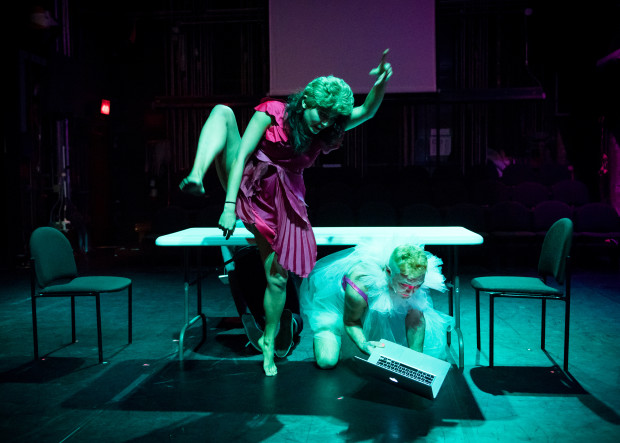
Photo credit: Ian Douglas
Why continue to make art if you’re a 43-year-old with no savings and no time for relationships? Choreographer Miguel Gutierrez wrestles with those personal doubts in Age & Beauty Part 2: Asian Beauty @ the Warq Meeting or The Choreographer & Her Muse or &:@&. Gutierrez is like the Louie of performance art; he’s absolutely self-deprecating, sometimes tediously so, but sometimes that depression resolves itself in a well-played joke. And though self-doubt constantly features throughout the performance, he keeps his head above water because of his longtime collaborators.
One by one, out came his collaborators. One woman, covered in pink, wore what looked like an LED-jumprope around her body. “The history of the muse is a complicated history,” she sang, semi-operatically. Then, from outside, sprang the others, a young blond dressed in a swimsuit, like Gutierrez in Age & Beauty Part 1, covered in a white tulle cape, and a regular-looking guy in a T-shirt and Chuck Taylors. I couldn’t keep up with all the lyrics, but the story was pretty much a litany of complaints about the dance industry (though they all apply to the art world at large): muses are a mess to deal with, but maybe the real muse takes the shape of an arts administrator, and nobody can actually create the type of work they want to make—“If you want to resist, you can’t pay rent.” (Welcome to the theme of American Realness.)
After the first number, Gutierrez introduced all those on stage: Michelle Boulé (the woman in pink), his dance “muse,” and Ben Pryor (the guy in tennis shoes), his arts administration “muse.” (Ben Pryor is also the producer of American Realness.) Both played themselves; Sean Donovan, a younger, blonder, perhaps more ideal version of Gutierrez, took the choreographer’s role on stage. Throughout the performance, there was very little in common with the two muses’ pieces; they showed the two poles pulling at Gutierrez: his creative life and administrative life.
Gutierrez did not spend much time on stage, reserving the most flattering praise, and the eyes of the crowd, for his collaborators: “I really love her,” “He’s the savviest motherfucker I’ve ever met.” (There were even more names he went on to praise, but Pryor and Boulé were the only muses who made on-stage appearances.) All this would have come across as a lovefest if it hadn’t been for Gutierrez’s constant self-deprecation. The only way for him to get on with life is to feel like he’s in it together, with others: “I feel bad about complaining. My life isn’t that bad, but if I’m not grateful, I feel like drowning.”
After introductions, Boulé danced to solo material from the 14 years spent working with Gutierrez—think of it as a greatest-hits compilation. At times she looked like a ninja-ragdoll, a powerful body not entirely in control of her limbs. In another dance she declared “I am perfect, you will love me” while stomping around the stage with one breast out. On stage she is a narcissistic Amazonian, a force to be reckoned with.
None of the administration-muse scenes could compare to the tornadic chaos produced by Boulé (though they the scenes did sometimes overlap). The office scenes were generally staid, with Donovan-as-Gutierrez and Pryor sitting at a table—sometimes walking around or crouched under the desk—while typing aloud and reading through emails taken from actual recordings at their office.
They are together, but distant. The two never seemed to take their eyes off their laptops; it was hard to find much of an emotional connection between the two, at least when working side by side. In one instance, Pryor went to meet his boss on the other side of the table to show him a dick pic sent to him by his then-current 20-something. It was one of the few times the two are shown to be physically close. In the world of administration, it’s better to keep boundaries, and keep your colleagues at arm’s length.
These scenes were not perfect. Office work does not become more exciting when shown on a stage. Talk was filled with writing grants, scheduling tours, and how, despite their hectic schedules, they didn’t have enough money to pay rent. There were some revealing meta-tidbits that went beyond the day-to-day drudgery. “Have you found any black people?” Donovan-as-Gutierrez asks Pryor about American Realness. And then there was Boulé, who, in between her furious dances, would sometimes crawl on their work table, a creative force to distract them. Still, the performance of administration could be as grueling for the audience as if they were filling out a spreadsheet.
By the end of the performance, everyone seemed exhausted, no one more so than Boulé who was covered in sweat, but gave a triumphant spoken-word solo (originally performed in Everyone and written by Gutierrez). She dragged the fold-out table downstage, where Gutierrez had been positioned, then stood atop it. “I am heartbroken,” she shouted before rapidly telling a story about running down a driveway, and pulling the audience members’ arms to come with her. She wanted a rapport with the audience, and she was screaming for it.
I had expected this to be the final number. The buildup roiled with intensity, and it was time to give that final exhale of pathos. It was time to wind down.

Photo credit: Ian Douglas
Then—all four performers came back on stage, all wearing pink costume dresses and singing a version of the introductory muse song. Pryor took on an angrier role, complaining that he is “a muse, too,” and “it’s not just emails.” As we’ve heard in many American Realness performances over the last two weeks, arts administration is integral to making a life in the industry. We hear you: arts administrators are just as important as any other muse. But there’s one thing these muses can’t provide: a different path to art-making, one where a savings account and a partner wouldn’t seem abnormal.


Comments on this entry are closed.